N19.biz (Virus Removal Instructions) - Free Guide
N19.biz Removal Guide
What is N19.biz?
N19.biz – a deceptive site which notifications should not be enabled
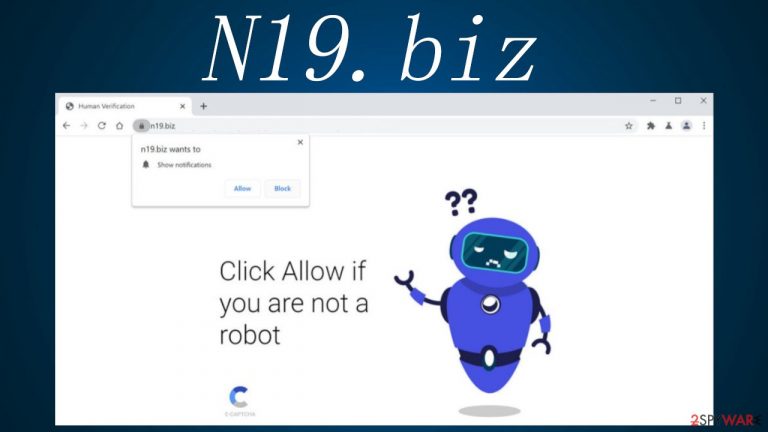
N19.biz is a push notification virus, and you could be redirected to it because of an adware infection, mistyped address, click of a deceptive ad on a shady website. Whatever the case might be, please don't accept its notifications as your screen or desktop will be bombarded with misleading ads.
Furthermore, this virus can open new tabs with affiliated pages on demand if a sudden redirect is triggered. Thus you would be forced into visiting various shady portals, with tech support scams, potentially unwanted programs (PUPs), porn, malware, gambling, and so on.
If you were tricked into pressing the Allow button on N19.biz, it's not the end of the world. By reading this article, you'll find out how to remove its notifications from your browser, how to eliminate adware (or other PUPs) that could have caused the initial redirect, and how to ensure that your device runs smoothly.
| name | N19.biz |
|---|---|
| Type | Push notification virus, PUP,[1] adware |
| IP address | 128.199.45.147 |
| Purpose | Deceive visitors into enabling its notification in order to generate revenue by redirecting internet traffic to affiliated partners |
| Symptoms | Ads in the form of notifications; browser launches or new tab opens with questionable portals out of nowhere; the device in use is working improperly |
| Risks | Installation of additional PUPs or malware, financial losses, identity theft, and other privacy issues |
| Distribution | Software bundles, freeware, deceptive ads, fake Flash Player updates |
| Elimination | Remove adware along with any other suspicious or malicious files/apps by scanning your device with a reputable anti-malware tool |
| System health check | If you want your device to run smoothly after an infection removal, you should consider using an all-in-one system diagnostics tool like the FortectIntego software |
People don't usually visit shady pages like N19.biz. They're redirected to them by potentially unwanted programs such as adware, browser hijackers, and alike. The same push notification virus might appear differently to users living in different countries or continents.
At the time of writing, the article's culprit asked to enable its notification to prove that we're not robots. Other page backgrounds and prompts, pushing to press the Allow button might include:
- confirm that you're over 18 years old,
- close the window,
- enter the site,
- continue watching,
- download file, etc.
Please be advised that if a website pushes to accept its notification by proving or continuing something, it's a push notification virus. Once the Allow button is pushed, ads will start to appear directly on your computer's desktop or phone/tablet screen.
Practically all ads from N19.biz virus are deceptive, meaning that they have nothing in common with the sites that you will be redirected to if you click them. But the worse part is that you might be forced to visit any of the infections affiliated pages if a sudden redirect is triggered.
Therefore, you should enable notifications only from legitimate sources and pages that you frequently visit and trust. You can remove shady site notifications (if you've accepted them) by using our detailed instructions displayed at the bottom of the article.
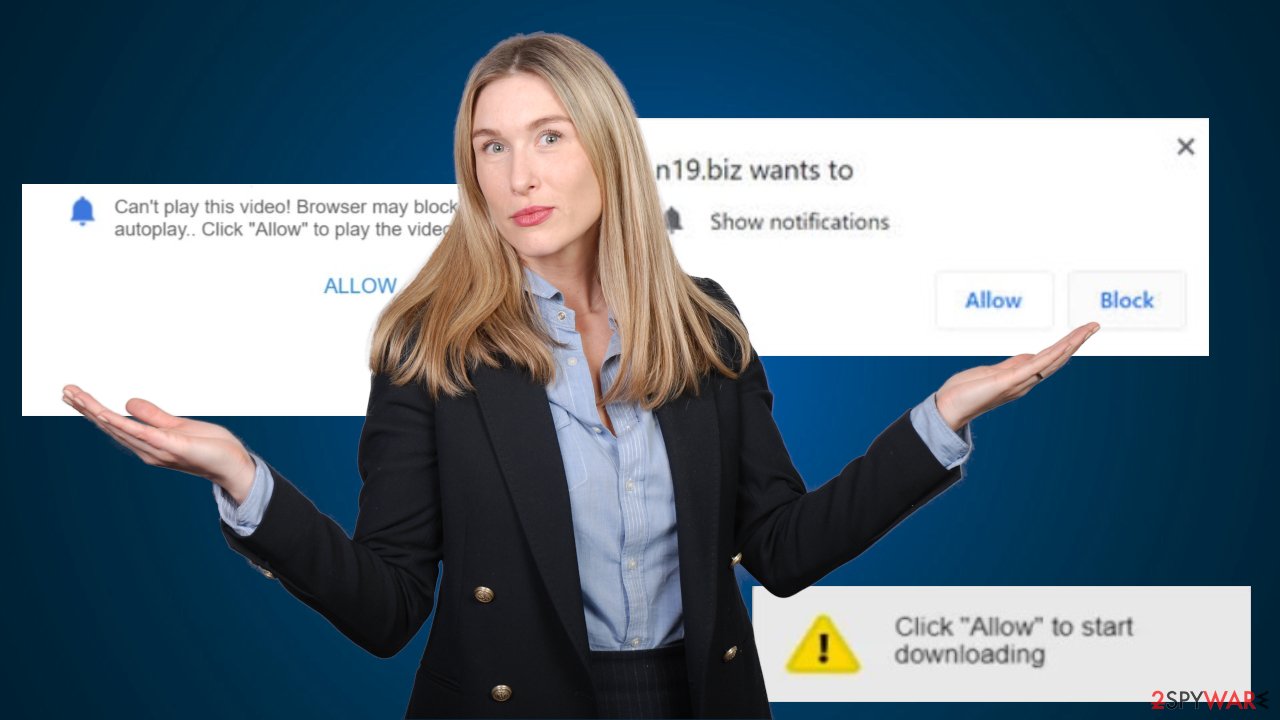
You should also take care of the adware that caused redirects to N19.biz. You can remove it by scanning your device with a trustworthy security tool. If you don't own one, we recommend downloading free anti-malware tools like SpyHunter 5Combo Cleaner or Malwarebytes that are more than suitable for this task.
And lastly, you have to repair system damage that the infection might have caused. According to cybersecurity specialists,[2] the best software for this job is the time-tested FortectIntego system diagnostics tool. It will fix any system irregularities and get rod of tracking cookies from dangerous portals.
Don't download Flash Player installers or updates as they harbor PUPs and malware
Many people still don't know that Flash Player was discontinued on December 31, 2020. The software is obsolete, and Adobe is recommending deleting it from every device for security purposes. Cybercriminals are exploiting this lack of knowledge.
You might encounter fake Flash Player update prompts either on treacherous or hacked websites. These prompts suggest that this software is outdated and you need to renew it. In fact, these downloads carry various infections, from PUPs to perilous malware, such as ransomware,[3] Trojans, etc.
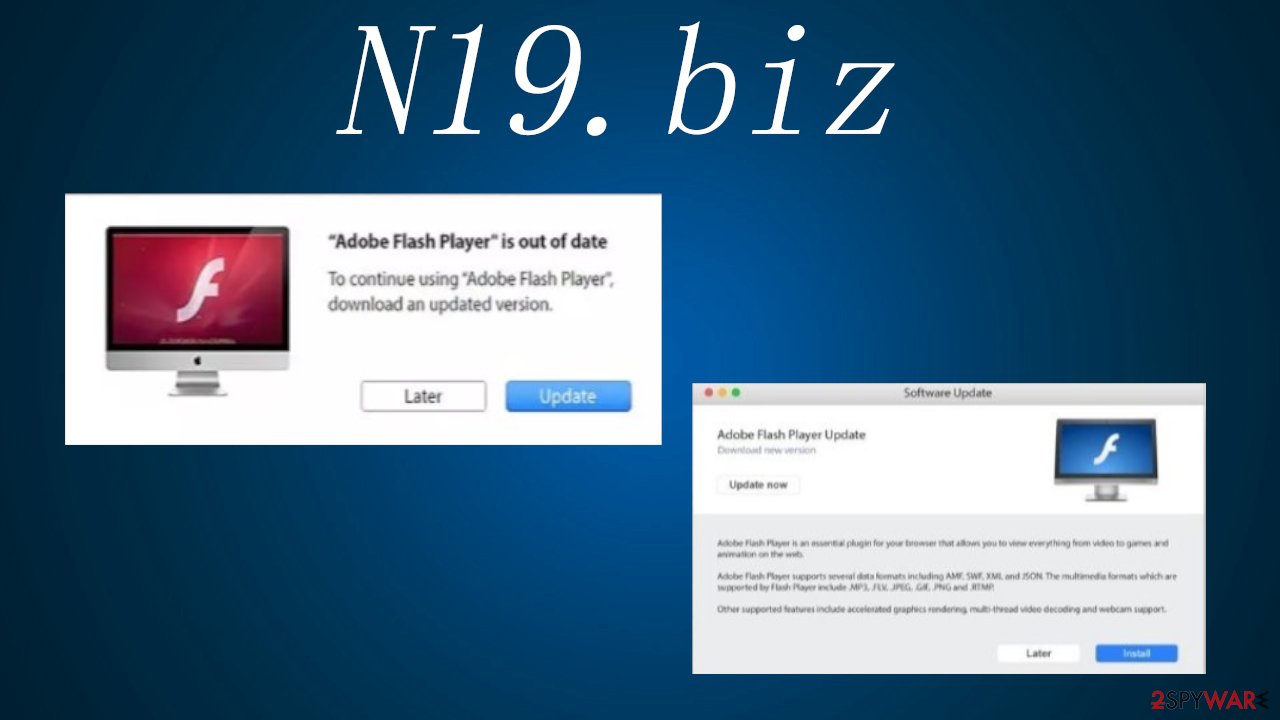
Thus if you ever see such a prompt, please don't believe it and don't click on it. Close the browser tab, perform system diagnostics to erase tracking cookies from that site, and never visit it again. Spread this information to your friends and family so they can enjoy their devices virus-free.
Remove N19.biz notifications from your browser with a few simple steps
Push notifications from N19.biz virus are actually ads that can be impossible to close. In some cases, the “X” button, which should remove the ad, either opens a new browser tab with a sponsored website or does nothing at all. This infection could only bring harm to you and your device in use.
Therefore, you need to remove it and PUPs that caused redirects. First, perform a full system scan with a reliable anti-malware tool. That should terminate adware along with any other suspicious files or apps. Please remember to keep the virus database of your AV tool constantly updated so it could stop the latest infections.
If you accepted notifications from N19.biz, please use our guides below to remove them from your browser. For your convenience, we've included instructions for Safari, Firefox, and other browsers. And finally, use a powerful system diagnostics tool to finish the removal by restoring any altered system values and deleting tracking cookies.
You may remove virus damage with a help of FortectIntego. SpyHunter 5Combo Cleaner and Malwarebytes are recommended to detect potentially unwanted programs and viruses with all their files and registry entries that are related to them.
Getting rid of N19.biz. Follow these steps
Stop browser notifications
Remove unwanted notifications from Google Chrome (desktop):
- Open Google Chrome browser and go to Menu > Settings.
- Scroll down and click on Advanced.
- Locate Privacy and security section and pick Site Settings > Notifications.

- Look at the Allow section and look for a suspicious URL.
- Click the three vertical dots next to it and pick Block. This should remove unwanted notifications from Google Chrome.

Remove unwanted notifications from Google Chrome (Android):
- Open Google Chrome and tap on Settings (three vertical dots).
- Select Notifications.
- Scroll down to the Sites section.
- Locate the unwanted URL and toggle the button to the left (Off setting).

Remove unwanted notifications from Mozilla Firefox:
- Open Mozilla Firefox and go to Menu > Options.
- Click on Privacy & Security section.
- Under Permissions, you should be able to see Notifications. Click the Settings button next to it.

- In the Settings – Notification Permissions window, click on the drop-down menu by the URL in question.
- Select Block and then click on Save Changes. This should remove unwanted notifications from Mozilla Firefox.

Remove unwanted notifications from Safari:
- Click on Safari > Preferences…
- Go to the Websites tab and, under General, select Notifications.
- Select the web address in question, click the drop-down menu and select Deny.

Remove unwanted notifications from MS Edge:
- Open Microsoft Edge, and click the Settings and more button (three horizontal dots) at the top-right of the window.
- Select Settings and then go to Advanced.
- Under Website permissions, pick Manage permissions and select the URL in question.

- Toggle the switch to the left to turn notifications off on Microsoft Edge.

Remove unwanted notifications from MS Edge (Chromium):
- Open Microsoft Edge, and go to Settings.
- Select Site permissions.
- Go to Notifications on the right.
- Under Allow, you will find the unwanted entry.
- Click on More actions and select Block.

Remove unwanted notifications from Internet Explorer:
- Open Internet Explorer, and click on the Gear icon at the top-right of the window.
- Select Internet options and go to the Privacy tab.
- In the Pop-up Blocker section, click on Settings.
- Locate web address in question under Allowed sites and pick Remove.

Uninstall from Windows
Instructions for Windows 10/8 machines:
- Enter Control Panel into Windows search box and hit Enter or click on the search result.
- Under Programs, select Uninstall a program.

- From the list, find the entry of the suspicious program.
- Right-click on the application and select Uninstall.
- If User Account Control shows up, click Yes.
- Wait till uninstallation process is complete and click OK.

If you are Windows 7/XP user, proceed with the following instructions:
- Click on Windows Start > Control Panel located on the right pane (if you are Windows XP user, click on Add/Remove Programs).
- In Control Panel, select Programs > Uninstall a program.

- Pick the unwanted application by clicking on it once.
- At the top, click Uninstall/Change.
- In the confirmation prompt, pick Yes.
- Click OK once the removal process is finished.
Delete from macOS
Remove items from Applications folder:
- From the menu bar, select Go > Applications.
- In the Applications folder, look for all related entries.
- Click on the app and drag it to Trash (or right-click and pick Move to Trash)

To fully remove an unwanted app, you need to access Application Support, LaunchAgents, and LaunchDaemons folders and delete relevant files:
- Select Go > Go to Folder.
- Enter /Library/Application Support and click Go or press Enter.
- In the Application Support folder, look for any dubious entries and then delete them.
- Now enter /Library/LaunchAgents and /Library/LaunchDaemons folders the same way and terminate all the related .plist files.

Uninstall from Android
Uninstall unwanted programs from Android device:
- Go to Settings -> Apps/Applications.
- Expand the full list of the installed apps.
- Scroll through the list and tap on a suspicious application once.
- Tap on it and select Uninstall.
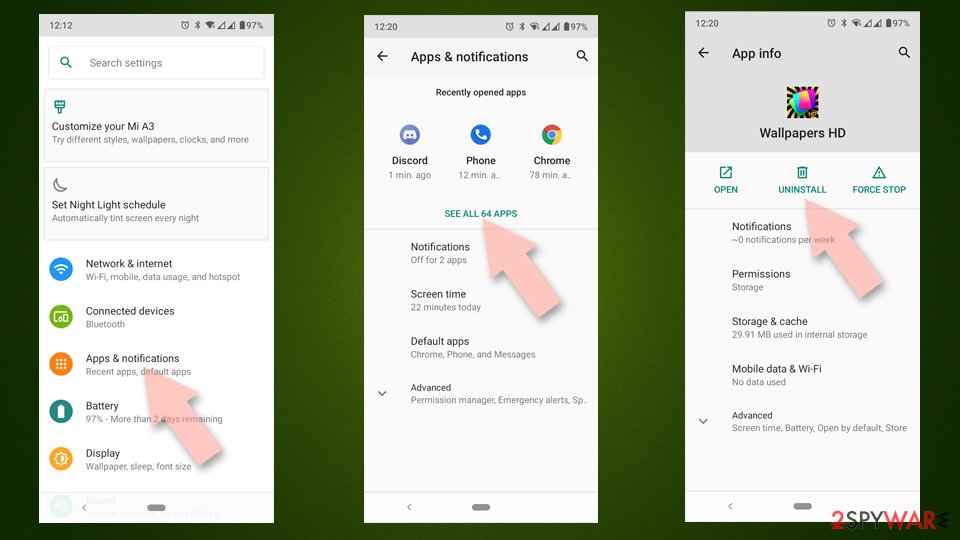
- Reboot the device.
Clear Storage and data files on Android from Google Chrome or other apps:
- Go to Settings > Apps/Applications.
- Expand the full list of the installed apps.
- Tap on Chrome and select Storage & cache.
- Clear storage and clear cache of the app.
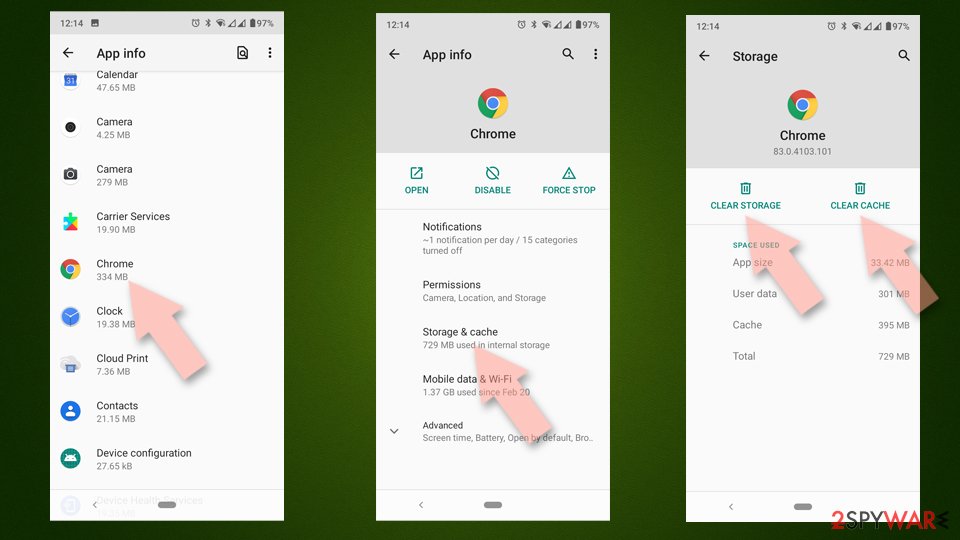
If you are seeing ads on top of other apps but are not sure what is causing it, perform the following steps:
- Go to Apps/Applications.
- Tap Advanced.
- Select Special App access.
- Tap on Display over other apps.
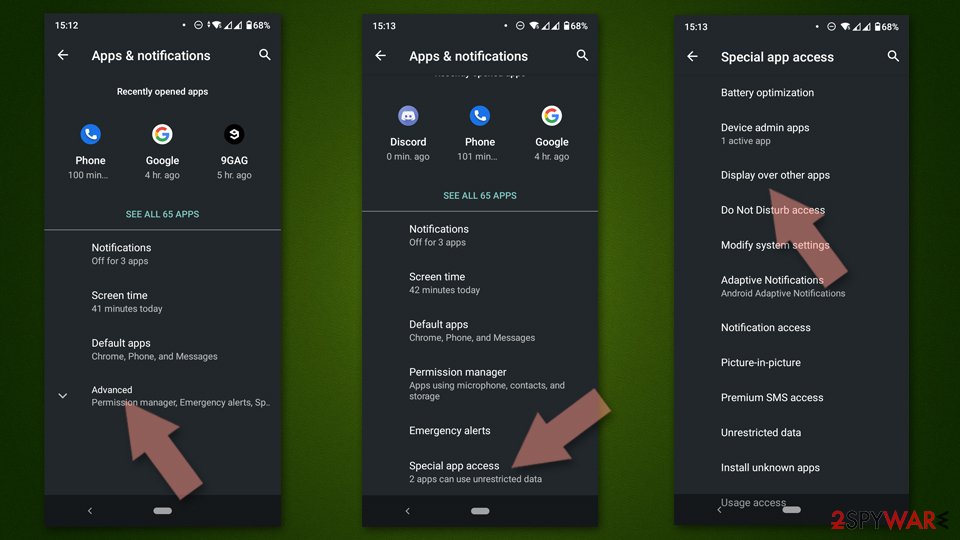
- Eliminate apps with these access rights enabled.
Remove from Microsoft Edge
Delete unwanted extensions from MS Edge:
- Select Menu (three horizontal dots at the top-right of the browser window) and pick Extensions.
- From the list, pick the extension and click on the Gear icon.
- Click on Uninstall at the bottom.

Clear cookies and other browser data:
- Click on the Menu (three horizontal dots at the top-right of the browser window) and select Privacy & security.
- Under Clear browsing data, pick Choose what to clear.
- Select everything (apart from passwords, although you might want to include Media licenses as well, if applicable) and click on Clear.

Restore new tab and homepage settings:
- Click the menu icon and choose Settings.
- Then find On startup section.
- Click Disable if you found any suspicious domain.
Reset MS Edge if the above steps did not work:
- Press on Ctrl + Shift + Esc to open Task Manager.
- Click on More details arrow at the bottom of the window.
- Select Details tab.
- Now scroll down and locate every entry with Microsoft Edge name in it. Right-click on each of them and select End Task to stop MS Edge from running.

If this solution failed to help you, you need to use an advanced Edge reset method. Note that you need to backup your data before proceeding.
- Find the following folder on your computer: C:\\Users\\%username%\\AppData\\Local\\Packages\\Microsoft.MicrosoftEdge_8wekyb3d8bbwe.
- Press Ctrl + A on your keyboard to select all folders.
- Right-click on them and pick Delete

- Now right-click on the Start button and pick Windows PowerShell (Admin).
- When the new window opens, copy and paste the following command, and then press Enter:
Get-AppXPackage -AllUsers -Name Microsoft.MicrosoftEdge | Foreach {Add-AppxPackage -DisableDevelopmentMode -Register “$($_.InstallLocation)\\AppXManifest.xml” -Verbose

Instructions for Chromium-based Edge
Delete extensions from MS Edge (Chromium):
- Open Edge and click select Settings > Extensions.
- Delete unwanted extensions by clicking Remove.

Clear cache and site data:
- Click on Menu and go to Settings.
- Select Privacy, search and services.
- Under Clear browsing data, pick Choose what to clear.
- Under Time range, pick All time.
- Select Clear now.

Reset Chromium-based MS Edge:
- Click on Menu and select Settings.
- On the left side, pick Reset settings.
- Select Restore settings to their default values.
- Confirm with Reset.

Remove from Mozilla Firefox (FF)
Remove dangerous extensions:
- Open Mozilla Firefox browser and click on the Menu (three horizontal lines at the top-right of the window).
- Select Add-ons.
- In here, select unwanted plugin and click Remove.

Reset the homepage:
- Click three horizontal lines at the top right corner to open the menu.
- Choose Options.
- Under Home options, enter your preferred site that will open every time you newly open the Mozilla Firefox.
Clear cookies and site data:
- Click Menu and pick Settings.
- Go to Privacy & Security section.
- Scroll down to locate Cookies and Site Data.
- Click on Clear Data…
- Select Cookies and Site Data, as well as Cached Web Content and press Clear.

Reset Mozilla Firefox
If clearing the browser as explained above did not help, reset Mozilla Firefox:
- Open Mozilla Firefox browser and click the Menu.
- Go to Help and then choose Troubleshooting Information.

- Under Give Firefox a tune up section, click on Refresh Firefox…
- Once the pop-up shows up, confirm the action by pressing on Refresh Firefox.

Remove from Google Chrome
Delete malicious extensions from Google Chrome:
- Open Google Chrome, click on the Menu (three vertical dots at the top-right corner) and select More tools > Extensions.
- In the newly opened window, you will see all the installed extensions. Uninstall all the suspicious plugins that might be related to the unwanted program by clicking Remove.

Clear cache and web data from Chrome:
- Click on Menu and pick Settings.
- Under Privacy and security, select Clear browsing data.
- Select Browsing history, Cookies and other site data, as well as Cached images and files.
- Click Clear data.

Change your homepage:
- Click menu and choose Settings.
- Look for a suspicious site in the On startup section.
- Click on Open a specific or set of pages and click on three dots to find the Remove option.
Reset Google Chrome:
If the previous methods did not help you, reset Google Chrome to eliminate all the unwanted components:
- Click on Menu and select Settings.
- In the Settings, scroll down and click Advanced.
- Scroll down and locate Reset and clean up section.
- Now click Restore settings to their original defaults.
- Confirm with Reset settings.

Delete from Safari
Remove unwanted extensions from Safari:
- Click Safari > Preferences…
- In the new window, pick Extensions.
- Select the unwanted extension and select Uninstall.

Clear cookies and other website data from Safari:
- Click Safari > Clear History…
- From the drop-down menu under Clear, pick all history.
- Confirm with Clear History.

Reset Safari if the above-mentioned steps did not help you:
- Click Safari > Preferences…
- Go to Advanced tab.
- Tick the Show Develop menu in menu bar.
- From the menu bar, click Develop, and then select Empty Caches.

After uninstalling this potentially unwanted program (PUP) and fixing each of your web browsers, we recommend you to scan your PC system with a reputable anti-spyware. This will help you to get rid of N19.biz registry traces and will also identify related parasites or possible malware infections on your computer. For that you can use our top-rated malware remover: FortectIntego, SpyHunter 5Combo Cleaner or Malwarebytes.
How to prevent from getting adware
Choose a proper web browser and improve your safety with a VPN tool
Online spying has got momentum in recent years and people are getting more and more interested in how to protect their privacy online. One of the basic means to add a layer of security – choose the most private and secure web browser. Although web browsers can't grant full privacy protection and security, some of them are much better at sandboxing, HTTPS upgrading, active content blocking, tracking blocking, phishing protection, and similar privacy-oriented features. However, if you want true anonymity, we suggest you employ a powerful Private Internet Access VPN – it can encrypt all the traffic that comes and goes out of your computer, preventing tracking completely.
Lost your files? Use data recovery software
While some files located on any computer are replaceable or useless, others can be extremely valuable. Family photos, work documents, school projects – these are types of files that we don't want to lose. Unfortunately, there are many ways how unexpected data loss can occur: power cuts, Blue Screen of Death errors, hardware failures, crypto-malware attack, or even accidental deletion.
To ensure that all the files remain intact, you should prepare regular data backups. You can choose cloud-based or physical copies you could restore from later in case of a disaster. If your backups were lost as well or you never bothered to prepare any, Data Recovery Pro can be your only hope to retrieve your invaluable files.
- ^ Chris Hoffman. PUPs Explained: What is a “Potentially Unwanted Program”?. Howtogeek. Online technology magazine.
- ^ Ioys. Ioys. Spyware news and security.
- ^ Ransomware. Wikipedia. The free encyclopedia.
